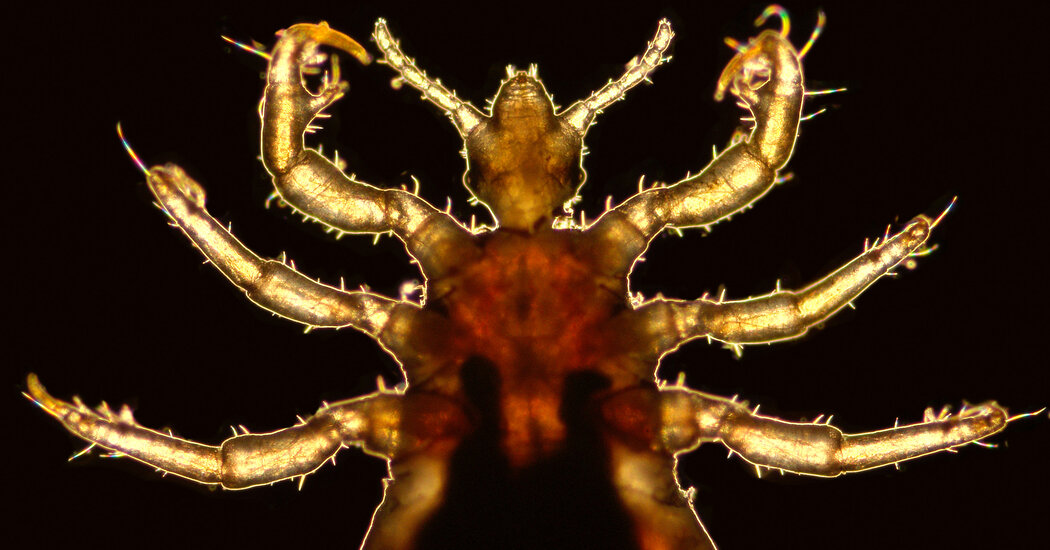Alongside our evolutionary journey from ape-like primates to bipedal apes to big-brained people, we have had the corporate of a really loyal companion: Pediculus humanus, also referred to as the human louse.
All alongside, the lice had this journey written into their genes. a New studyFor instance, I discovered that some lice within the Americas are hybrids of these carried by Native People and others carried throughout the Atlantic by European colonists.
“We people don’t dwell in a bubble,” mentioned Marina Asconis, an evolutionary geneticist on the USDA and creator of the brand new examine. “Lice is a part of our lives and our historical past.”
Lice often inhabit folks’s heads, attaching themselves to hair shafts, piercing the scalp, and consuming blood. As a result of they can’t survive outdoors of human our bodies, the parasites bounce from individual to individual. If persons are crammed collectively in unsanitary circumstances — akin to an overcrowded jail — lice can unfold by way of clothes and feed on different elements of the physique.
Different mammals and birds have their very own lice. Every sort of parasite has outstanding variations to its explicit host, whether or not it’s a penguin or a bat. This intimacy is historical. Found by paleontologists in Germany A louse that is 44 million years old With items of feathers preserved in its entrails.
Lice fossils are too uncommon to disclose a lot about their historical past. However their DNA comprises many extra clues. By analyzing genetic materials from lice, entomologists can construct their household bushes, revealing which species are most carefully associated.
Typically, the closest relative of a lice species lives on the closest relative of its host. For instance, within the early 2000s, David Reed of the College of Florida and his colleagues discovered that human lice are carefully associated to lice that dwell on chimpanzees and much more carefully associated to lice that dwell on monkeys. In different phrases, lice have been following us alongside our evolutionary path for 25 million years.
This doesn’t imply that lice are utterly loyal. One other species, Pthirus pubis (generally referred to as crabs), inhabits solely human pubic hair. Cancers are usually not carefully associated to move lice. As a substitute, Dr. Reed and his colleagues found that their closest cousins are the lice that dwell on them Gorilla. Early human ancestors probably picked up the crabs whereas sleeping in an historical gorilla nest, or feeding on gorilla carcasses.
In one other provocative examine, Dr. Reed and his colleagues in contrast human lice from completely different elements of the world. They checked out genetic materials referred to as mitochondrial DNA, which is just handed from females to their offspring. The researchers discovered that many lice belong to one of many two subspecies. It’s noteworthy that these lineages separated from a feminine louse which will have lived 1,000,000 years in the past.
Dr. Reed and his colleagues speculated that this deep break up occurred when people expanded out of Africa. Together with their very own lice, they picked up lice from Neanderthals or another extinct group of people.
Not too long ago, lice researchers have turned their consideration to the chromosomal DNA that lice inherit from their moms and dads.
In 2010, Dr. Asconci joined Dr. Reed’s staff and led efforts to gather such DNA from a wider area of the world.
Within the new examine, printed Wednesday within the journal PLOS ONE, Dr. Asconci and her colleagues analyzed DNA from 274 lice collected from folks in 25 locations world wide, together with Honduras, France, Rwanda and Mongolia.
DNA revealed two geographic populations of lice. Certainly one of them was current in Africa, Asia and the Americas. Amongst these lice, researchers discovered a detailed genetic hyperlink between Honduras and Mongolia. They believe this kinship is an indication that Asian individuals who first unfold into the Americas about 23,000 years in the past introduced lice with them.
The remaining lice fashioned a second group, which researchers present in Europe, in addition to in the US, Mexico and Argentina. The researchers additionally discovered 33 hybrids from the 2 teams, 25 of which dwell within the Americas.
Dr. Asconci and her colleagues see these findings as a file of current historical past: European colonists sailed to the New World, bringing their lice with them. Within the Americas, the second group unfold and generally ended up on the heads of individuals already infested with lice from the primary group.
But when these lice are certainly colonial hybrids, Dr. Asconis and her colleagues are puzzled that they have not discovered extra. The rarity of hybrids could also be the results of some type of barrier to hybridization. It’s potential that the 2 teams of lice have been remoted from one another for thus lengthy that they acquired mutations that didn’t work effectively after they have been combined collectively once more.
Dr. Ascones mentioned that researchers within the subject of lice are nonetheless firstly of their work. Within the new examine, she and her colleagues checked out simply 16 small areas of the louse’s DNA. The subsequent wave of analysis will look at your entire louse genome, and he or she expects this new knowledge will yield extra insights.
It is perhaps potential, for instance, to know how human lice advanced the flexibility to maneuver from the top to the physique, and why physique lice solely carry microbes that may trigger ailments akin to typhus. Researchers might be able to decide how our ancestors caught the lice that also trouble us right this moment.
“The genetic info we see in present human lice can nonetheless inform us issues about our human previous,” Dr. Asconci mentioned.

